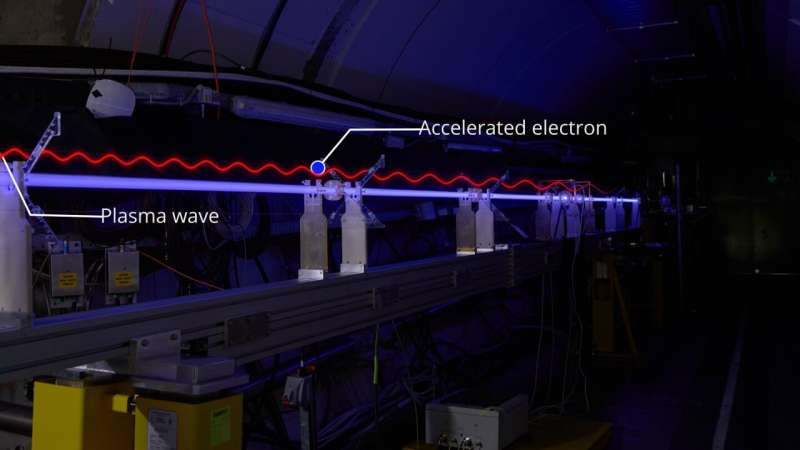This article has been reviewed according to Science X's editorial process and policies. Editors have highlighted the following attributes while ensuring the content's credibility:
fact-checked
trusted source
proofread
AWAKE introduces a stronger wave to accelerate particles

"Plasma wakefield acceleration is like surfing," says Edda Gschwendtner, leader of the AWAKE accelerator R&D project at CERN.
AWAKE is all set to begin its second phase of data taking on 31 July—with a brand-new plasma source. While various future collider proposals aim to increase the size of an accelerator to increase the energy of the particles, AWAKE would help to figure out the opposite: how to shrink the size of a particle accelerator while still achieving higher energies, using a new way of accelerating particles.
"Imagine a boat on a lake and surfers waiting for a wave. The boat passes by the surfers and creates waves, the surfers jump on the wave and also get accelerated. We do the same in plasma wakefield acceleration. We have plasma (the lake) in which the beam (the boat) drives waves, and then we inject particles (surfers) on the waves to get accelerated," explains Gschwendtner in her TEDxCERN talk.
A plasma wakefield is a type of wave generated by particles traveling through a plasma. AWAKE sends proton beams from the Super Proton Synchrotron (SPS) through plasma cells to generate these fields. A second beam—the "witness" electron beam (the surfers)—is then accelerated by the wakefields, gaining up to several gigavolts of energy. Striving to demonstrate the benefits of plasma wakefield acceleration over conventional technologies such as radiofrequency cavities, AWAKE has implemented new plasma-source prototypes and approaches.
AWAKE's new rubidium vapor plasma source is 10 meters long, similar to that used in previous runs, but this time it introduces a density step that allows stronger wakefields to be obtained. This new plasma source is split into segments whose temperature can be controlled independently along the entire length of the source.
The old plasma source was removed from the tunnel a few months ago to welcome the upgraded version, which was developed jointly by the Max Planck Institute for Physics in Munich, Germany and Wright Design in the UK. This also offered a unique opportunity to test another prototype: the discharge plasma source, developed by IST-Lisbon in Portugal and the Vacuum, Surfaces and Coatings group at CERN. The discharge plasma source is a potential candidate for AWAKE's operation after CERN's third long shutdown. It has the potential to be scaled up beyond 10 meters, but would not need to be on the tens-of-kilometer scale required by conventional accelerator technologies.
"The longer the plasma source, the higher the energy of the witness beam would be," says Alban Sublet, an applied physicist in the Vacuum, Surfaces and Coatings group, on the advantage of a scalable plasma source. "We managed to perform a variety of measurements during the test with the discharge plasma source, for example we investigated how different gases such as helium or xenon, different gas pressures and different plasma lengths affect the proton beam and the wakefields."
Both the rubidium vapor source and the discharge plasma source aim to achieve the same properties of the plasma but in different ways: by laser ionization for the rubidium source and by pulsed direct current (DC) discharge in different gases for the discharge plasma source. Thanks to its clear scientific roadmap, AWAKE has already come a long way and is looking ahead to its first particle physics applications for the next decade.
"The AWAKE experiment started in 2016 and the first two years were proof of concept. We managed to show that indeed we can use the proton beam from the SPS to drive the wakefield in a 10-meter-long plasma source. We also managed to accelerate electrons already to a very high energy. We were very happy about that," says Gschwendtner. "Now we are moving on to the next phase in the experiment, in which we want to demonstrate that we can accelerate electrons to high energies and control the beam quality. This is very important because this is what we need for a real accelerator."
Provided by CERN


















